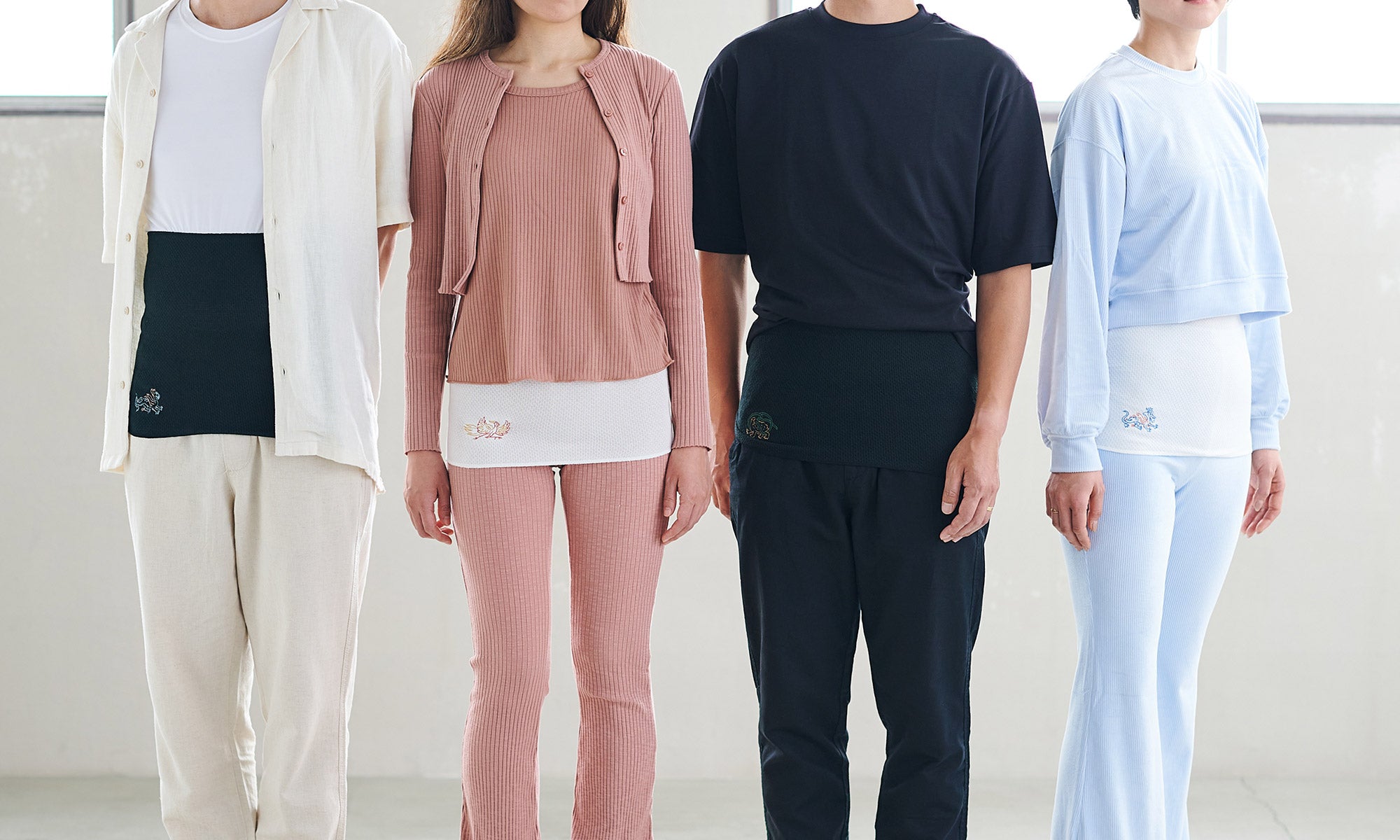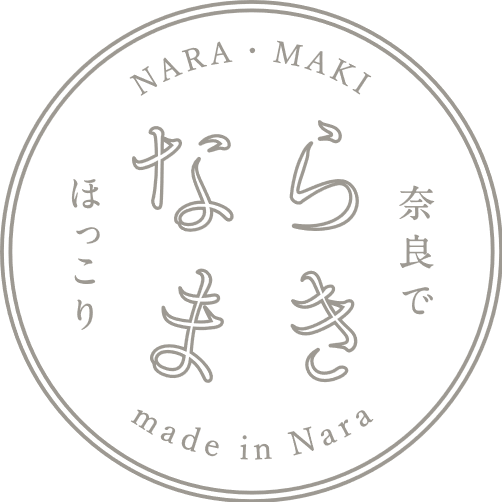ABOUT NARAMAKI
― What is a haramaki ―
Since ancient times in Japan, feeling cold has been said to cause of all sorts of ailments . In order to strengthen the body’s resistance to illness, it is important to increase one’s immunity by keeping warm.
In particular, warming up the abdomen (where the intestines are located) is said to increase gut immunity, and therefore is an efficient way to boost the body’s overall immunity.
Japanese people have been wrapping their abdomens in belly wraps called haramaki since childhood. Gently wrapping the abdomen with haramaki is a way of protecting the body for a healthier life.

ABOUT NARAMAKI
Brand concept
Wrap your body and mind in the charms of Nara
The concept behind the brand is to wrap yourself in the charms of Japan’s ancient capital, Nara. This high-performance, Japan-made haramaki (belly wrap) keeps your body healthy and comfortable while soothing your mind with its warmth and Nara-inspired embroidered motifs.
Sock manufacturing has long been one of Nara’s local industries, and the prefecture is still Japan’s largest producer of socks.
For nearly the past century, our company has been manufacturing and selling socks and textile products in Nara. During this time, we have developed various technologies for manufacturing socks, haramaki, and other quality products. Our new brand, NARAMAKI, was launched with the desire to create products that contribute to Nara, our hometown. We hope you will feel the charms of Nara by using NARAMAKI.

What makes NARAMAKI so special ?
We designed the NARAMAKI to be “super thin” so that you can wear it all year round, regardless of the season.
It is only about 0.9 mm thick, and because we used circular knitting to create a tubular shape without seams, it will wrap comfortably around your abdomen in all four seasons without affecting the fit of your clothes.
Since haramaki are worn next to the skin, we were also concerned about the feel of the fabric. We chose a fabric that combines the best of both worlds: smooth cotton, which is highly absorbent and breathable, and silk, which is the closest natural fiber to human skin and is excellent at retaining moisture.
NARAMAKI is soft and smooth to the touch, warm yet breathable. We recommend it not only for cold winters, but also for early spring, air conditioning, and cool nights.
Properties of cotton
- Cotton is highly absorbent and breathable, wicking moisture away from the body. It is also less likely to build up or discharge static electricity.
- Cotton’s delicate fibers feel smooth to the touch with minimal snagging on the skin.
- Cotton material is resistant to damage and can withstand repeated washing due to its high strength.
Properties of silk
- Silk contains 18 types of amino acids and is said to be the closest natural fiber to human skin.
- Silk keeps you dry and comfortable as you sweat thanks to its excellent balance of water absorption and release properties.
- Silk is made up of bundles of proteins. It has extremely low thermal conductivity and excellent moisture retention properties. It feels warm in the winter and cool and comfortable in the summer.
Embroidered charms
A simple and endearing embroidered motif adorns each NARAMAKI, protecting your belly.
Super thin haramaki, series 1: Lucky motifs of Nara
Each haramaki has been embroidered with a motif associated with the ancient capital of Nara that serves as a lucky charm.

Mother Deer and Fawn
Deer in Nara Park. In Nara, deer are considered to be divine messengers and have been protected since ancient times.
Daibutsu
The Great Buddha of Nara built in the eighth century.
Narazuke
(Local food from Nara) Traditional pickles made by pickling vegetables in sake lees.
Persimmon Leaf Sushi
(Local food from Nara) Sushi made by wrapping mackerel and salmon in persimmon leaves.
Lapis Lazuli Cup in the Shosoin Repository
A beautiful cobalt blue glass cup. One of the treasures stored in the Shosoin Repository, which houses treasures from the eighth century.
Envoy Ship to Tang Dynasty China
During the Nara period between the sixth and eighth centuries, Japan sent these ships from the ancient capital of Nara to the Tang dynasty in China.
Golden Kite
This bird is said to have guided the first emperor of Japan to build the capital.
Super thin haramaki, series 2: Kitora Tumulus Mural Paintings
Embroidered charms inspired by the Kitora Tumulus.
Our second series of embroidery motifs was inspired by the Four Divine Creatures and Star Atlas mural paintings (National Treasures) on the walls of the Kitora Tumulus located in Asuka, Nara Prefecture.
―What is the Kitora Tumulus ?
The Kitora Tumulus is a burial mound (kofun) erected on Abeyama, a small hill located in the southwestern part of Asuka Village, Takaichi District, Nara Prefecture.
This small burial mound is located in the ancient necropolis for members of the imperial family and nobles that lies south of the site of Fujiwara-kyo, one of the ancient capitals of Japan. It is thought to have been erected in the late 7th or early 8th century.
The burial chamber contains mural paintings of the Four Divine Creatures of the compass points, the 12 signs of the Chinese Zodiac, Star Atlas, and the Sun and Moon. The Four Divine Creatures and the Star Atlas mural paintings were listed as National Treasures in 2019.
In Feng Shui, the cardinal directions are ruled by Four Divine Creatures: the Azure Dragon in the east, the Vermillion Bird in the south, the White Tiger in the west, and the Black Tortoise in the north.
Therefore, it is said that cities with a river to the east, a large pond or ocean to the south, a road to the west, and mountains to the north will be especially prosperous.
Since ancient times, this idea was believed not only in China, the origin of Feng Shui, but also in Japan. This idea also influenced how the capitals of Nara were built.

Azure Dragon青龍(Seiryu)
The Azure Dragon, who rules over spring, protects the eastern direction. As the name suggests, it is blue-green. The Azure Dragon is a divine dragon with the horns of a deer and the tail of a snake, symbolizing the flow of a river. It may bring you luck in friendship and wealth.
Vermilion Bird朱雀(Suzaku)
The Vermillion Bird, who rules over summer, protects the southern direction. The color red represents the Fire element. The Vermillion Bird is said to control fire and have beautifully colored feathers. We recommend this motif for those seeking to enhance their beauty and intelligence.
White Tiger白虎(Byakko)
The White Tiger, who rules over autumn, protects the western direction. Like the name, it is white. While the Azure Dragon, Vermillion Bird, and Black Tortoise are all mythical creatures, this sacred beast was modeled after an existing animal. The White Tiger represents authority and is also considered to be the god of children and safe childbirth.
Black Tortoise玄武(Genbu)
The Black Tortoise, who rules over winter, protects the northern direction. The color black represents darkness. The Black Tortoise is a long-legged tortoise entwined with a snake, said to represent the underworld, the realm of the dead, and the psyche of the cosmos itself. It is a symbol of longevity and offers protection against disease.
Star Atlas
In ancient China, people believed that there was a world in the heavens ruled by a celestial emperor. The Kitora Star Atlas was drawn in accordance with this heavenly worldview. The black NARAMAKI is embroidered with the Kitora Tumulus Star Atlas mural painting, while the white NARAMAKI is embroidered with an astronomical chart inspired by outer space.
